|
|
|
Castledermot (15km
south-east of Athy) originally
called Diseart Diarmada, and later Tristle-Dermot is a must for historians. The town
contains a 14th century Franciscan Abbey, a Hibernian-Romanesque arch, a 10th century
round tower, two 9th century high crosses and a number of ancient stones and grave slabs.
| THE ABBEY A step through a gateway at the
southern end of this straggling town takes visitors back 800 years . In an instant one enters into the stillness of the
Franciscan Abbey which was founded in 1302 by Thomas, Lord Offaly, with the help of the de
la Hoyde family who were its benefactors. |
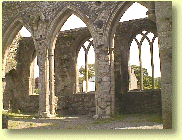 |
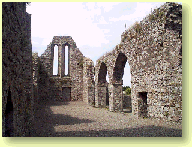 The Abbey was plundered by Robert Bruce in 1317. Later, in 1541, the friary
was suppressed. Only the walls of the church remain, which was originally a long rectangular
structure with a doorway, a pair of lancet windows in the west wall and a tower on the
south side. The north transept was added to it later and this is probably identical
to the chapel of St. Mary built by Thomas, Second Earl of Kildare in 1328. Attached to the
ruins of the church is a square building known as the Abbey Castle, which possibly dates
from the 15th century and would have served as accommodation for the monks.
The ruins are set back from the main road by only two or three feet, which makes it all
the more remarkable that they have survived for so long. The solid stonework is well
preserved, seeming as secure and strong as the day it was first constructed. The Abbey was plundered by Robert Bruce in 1317. Later, in 1541, the friary
was suppressed. Only the walls of the church remain, which was originally a long rectangular
structure with a doorway, a pair of lancet windows in the west wall and a tower on the
south side. The north transept was added to it later and this is probably identical
to the chapel of St. Mary built by Thomas, Second Earl of Kildare in 1328. Attached to the
ruins of the church is a square building known as the Abbey Castle, which possibly dates
from the 15th century and would have served as accommodation for the monks.
The ruins are set back from the main road by only two or three feet, which makes it all
the more remarkable that they have survived for so long. The solid stonework is well
preserved, seeming as secure and strong as the day it was first constructed.
- The key is available from the caretaker’s house next door. |
ST. JAMES'S CHURCH OF IRELAND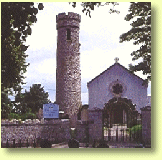 A short walk from the Abbey is St. James’s
Church of Ireland. An attractive tree lined avenue leads from the main road to the
churchyard. Inside there are a number of historical features which go back even
farther in time then the Franciscan Abbey, to the 12th and even to the 9th century.
A short walk from the Abbey is St. James’s
Church of Ireland. An attractive tree lined avenue leads from the main road to the
churchyard. Inside there are a number of historical features which go back even
farther in time then the Franciscan Abbey, to the 12th and even to the 9th century.
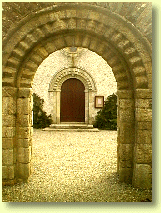
St. James’s Church lies on the site of a monastery founded around 800 by the
father of St.Diarmuid, after which Castledermot takes its name. The monastery was
raided by the Vikings in the 9th century, but continued its existence at least until the
12th century. All that is left today is a splendidly reconstructed Romanesque doorway,
which came from a church that has since vanished, a 10th-century Round Tower, 66ft high
with granite base, and two magnificent High Crosses, probably 9th century.
ROUND TOWER
The round tower stands on the north side of St. James church, to
which it is attached by an ancient narrow and high passage 8’ in length. The masonry consists of rough unworked granite boulders. The spaces between
them are filled up with common quarry stores embedded in the mortar. The height of the tower is 66.5’ and the walls at the base are 3.5’and
are inclined upwards.
HIGH CROSSES
Richly carved with
depictions of the Crucifixion, Adam and Eve, Daniel in the Lions’ Den, the Sacrifice
of Isaac, these High Crosses are among the best preserved of the granite crosses in the
Barrow valley. The North Cross shows David with his harp, one of the few images from
this time of an Irish harp. The south cross's east face is richly decorated with
abstract Celtic design.
Also in the churchyard are the foundations of a medieval church and a number of well
preserved early Christian and medieval grave slabs. |
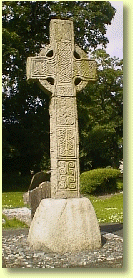 |
|


Kildare
Community
Network Link
|